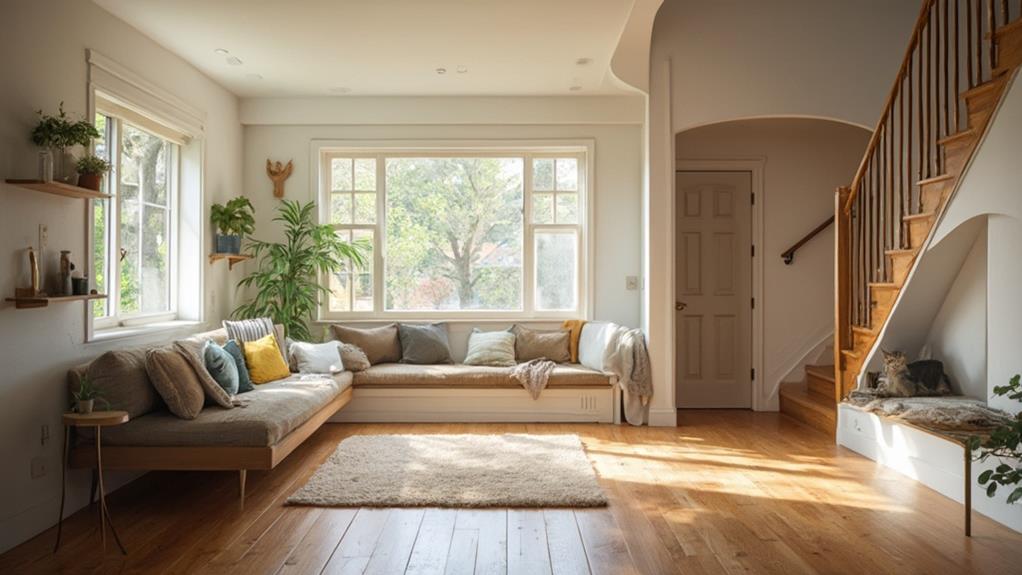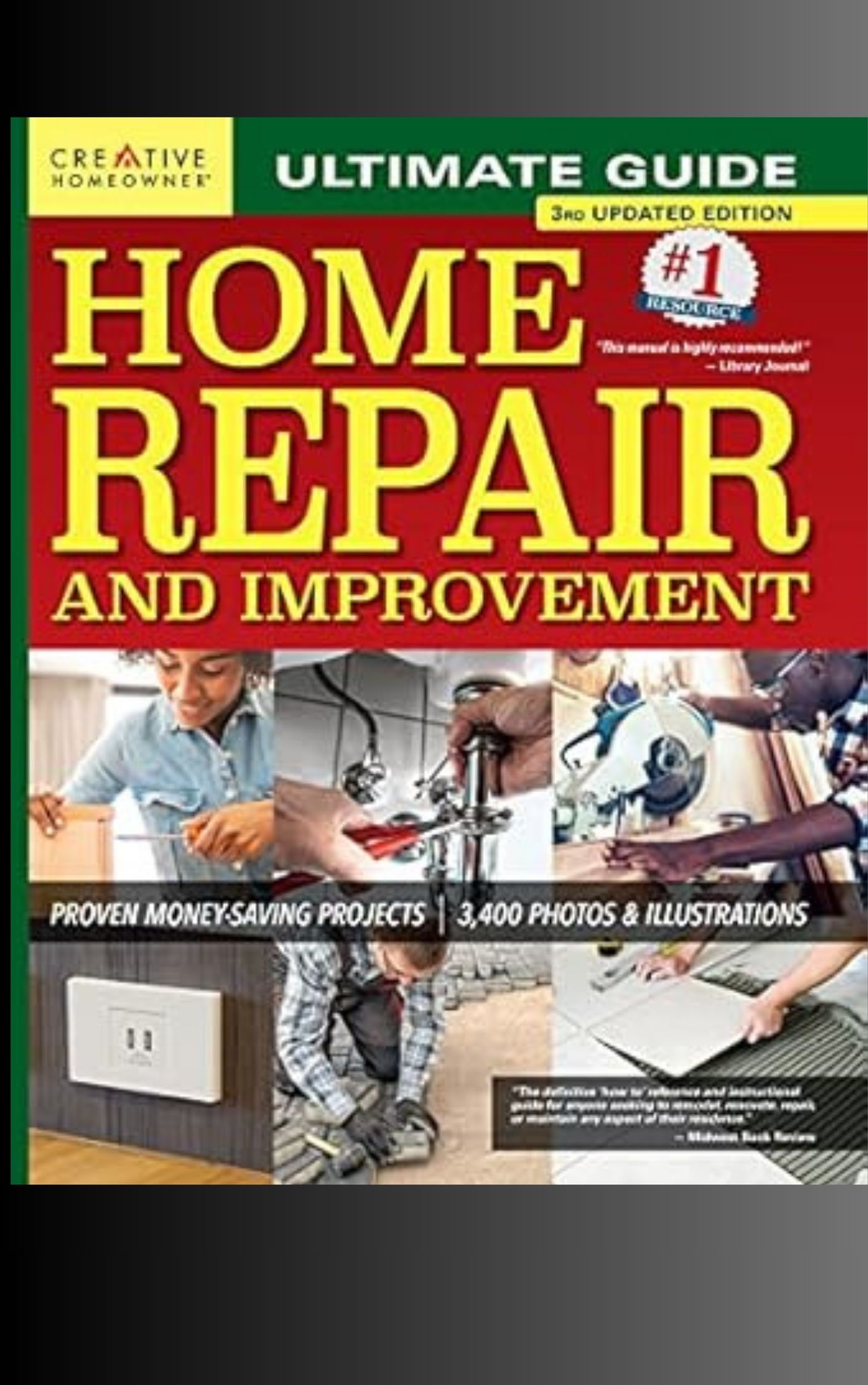When incorporating pet-friendly features in your home renovation, focus on durable materials and practical design elements. Choose scratch-resistant flooring like luxury vinyl plank or ceramic tiles, and opt for easy-to-clean furniture with pet-friendly fabrics such as leather or microfiber. Implement creative storage solutions for pet supplies, and designate specific areas for feeding, grooming, and rest. Prioritize safety by securing loose wires, installing childproof locks, and using pet-safe materials throughout your home. Consider easy-clean design elements like low-pile carpets and washable fabrics for upholstery and window treatments. By thoughtfully integrating these features, you'll create a harmonious living space that caters to both human and pet needs. The following sections explore these concepts in greater detail.
Durable Flooring Options
Several durable flooring options are available for pet owners looking to renovate their homes. Luxury vinyl plank (LVP) flooring is an excellent choice, offering both style and resilience. It's scratch-resistant, water-resistant, and easy to clean, making it ideal for households with pets.
Ceramic or porcelain tiles are another durable option, known for their longevity and resistance to scratches and stains. These materials are also simple to maintain and can withstand heavy foot (and paw) traffic.
For those preferring a warmer feel underfoot, engineered hardwood is a viable alternative. It offers better moisture resistance than traditional hardwood and can be refinished if scratched. Cork flooring is another pet-friendly option, providing natural cushioning and sound absorption while being resistant to scratches and bacteria. Polished concrete is an increasingly popular choice for its durability and low maintenance requirements, though it may require area rugs for pet comfort.
When selecting flooring, consider factors such as scratch resistance, water resistance, and ease of cleaning. Additionally, choose colors and patterns that can help conceal pet hair and minor scratches, ensuring your floors look great for years to come.
Pet-Friendly Furniture Choices
With durable flooring in place, pet owners can turn their attention to selecting furniture that withstands the rigors of life with animals. When choosing pet-friendly furniture, opt for materials that resist scratches, stains, and odors. Leather and microfiber are excellent choices for upholstery, as they are easy to clean and maintain.
Avoid delicate fabrics like silk or velvet, which can easily snag or trap pet hair. Consider furniture with removable, machine-washable covers for easy cleaning and maintenance. Slipcovers can protect sofas and chairs from fur, drool, and accidents.
For wooden furniture, select pieces with durable finishes that can withstand occasional scratches. Distressed or rustic styles can help camouflage minor damage. Opt for furniture with raised legs to facilitate cleaning underneath and prevent pets from using lower areas as hiding spots.
Multi-functional pieces, such as ottomans with storage, can serve as both seating and a place to stow pet toys. When selecting tables, choose those with rounded edges to prevent injuries during playtime. By incorporating these pet-friendly furniture choices, homeowners can create a comfortable living space that accommodates both human and animal family members.
Creative Storage Solutions
Organizing pet supplies efficiently is crucial for maintaining a tidy and functional home. Creative storage solutions can help pet owners keep their living spaces clutter-free while ensuring easy access to essential items. Consider installing built-in cabinets or shelving units specifically designed to house pet food, toys, and grooming tools.
Utilize vertical space by mounting wall-mounted organizers or pegboards to store leashes, collars, and small accessories.
Repurpose furniture pieces, such as ottomans or benches with hidden storage compartments, to conceal pet beds or litter boxes. Incorporate pull-out drawers in lower kitchen cabinets to store food and water bowls when not in use. For smaller homes, opt for multi-functional furniture like end tables with built-in pet crates or window seats with integrated storage for toys and treats.
Create designated pet zones by installing custom-built nooks or alcoves for feeding stations and sleeping areas. Use decorative baskets or attractive containers to store pet items in plain sight without compromising aesthetics. Consider installing a mudroom with built-in cubbies and hooks for leashes, towels, and outdoor gear. These creative storage solutions will help maintain a clean, organized living space while accommodating your pets' needs.
Designated Pet Spaces
Creating dedicated areas for pets within the home is essential for their comfort and well-being. These designated spaces provide pets with a sense of security and help maintain order in the household. Consider incorporating built-in feeding stations in the kitchen or utility room, complete with storage for food and accessories. A custom nook under the stairs or in a spare corner can serve as a cozy retreat for dogs or cats.
For cat owners, wall-mounted shelves and perches offer vertical space for climbing and lounging. Installing a catio—an enclosed outdoor area—allows felines to safely enjoy fresh air and sunshine. Dog owners might consider a dedicated grooming station in the laundry room or garage, equipped with a low-level shower or wash basin.
In bedrooms or living areas, integrate pet beds into furniture designs or create window seats that double as resting spots. For homes with multiple pets, consider installing pet gates or doors to manage access to different areas. These thoughtful additions not only cater to your pets' needs but also seamlessly blend with your home's aesthetic, creating a harmonious living environment for both humans and animals.
Safety Considerations
Safety considerations are paramount when renovating a home to accommodate pets. When planning your pet-friendly renovation, focus on potential hazards and implement preventive measures. Secure loose wires and cords to prevent chewing and strangulation risks. Install childproof locks on cabinets containing cleaning supplies, medications, and other toxic substances. Choose pet-safe materials for flooring, furniture, and window treatments to avoid ingestion of harmful fibers or chemicals.
Ensure windows have secure screens to prevent falls, especially for cats. Install stair gates to control access to certain areas and prevent accidents. When designing outdoor spaces, use pet-safe plants and avoid toxic varieties. Secure trash cans and compost bins to prevent pets from accessing potentially harmful contents. Consider installing a pet door with a locking mechanism for controlled outdoor access.
In the kitchen, opt for induction cooktops or stove knob covers to prevent accidental burns. Use non-slip surfaces in bathrooms and other wet areas to prevent slips and falls. Install carbon monoxide and smoke detectors at pet-level heights for early warning. By prioritizing these safety considerations, you can create a pet-friendly home that minimizes risks and maximizes comfort for your furry companions.
Easy-Clean Design Elements
While safety is a top priority in pet-friendly renovations, maintaining a clean home with furry companions can be challenging. Incorporating easy-clean design elements can significantly reduce the time and effort required for upkeep.
Opt for durable, stain-resistant flooring materials like luxury vinyl, tile, or sealed hardwood. These surfaces are less likely to absorb pet odors and can be easily wiped clean. Consider installing low-pile carpets in select areas, as they trap less fur and dander compared to plush alternatives.
Choose washable fabrics for upholstery and window treatments. Microfiber and leather are excellent choices for furniture, as they resist pet hair and can be quickly wiped down. Install removable, machine-washable slipcovers for added protection.
Incorporate built-in storage solutions for pet supplies, making it easier to keep the living space tidy. Install a dedicated pet washing station in a mudroom or laundry area to contain messes during grooming sessions.
Select paint finishes that are easy to clean, such as semi-gloss or satin, for walls and trim. These surfaces can be wiped down without damaging the paint. Finally, consider installing a central vacuum system with strategically placed outlets for efficient fur removal throughout the home.
Frequently Asked Questions
How Can I Soundproof My Home to Reduce Pet Noise?
To soundproof your home and reduce pet noise, consider installing acoustic panels, using soundproofing curtains, and adding weatherstripping to doors. Implementing double-pane windows, using thick carpets or rugs, and sealing gaps in walls can also significantly minimize sound transmission.
What Plants Are Safe to Include in a Pet-Friendly Home Renovation?
Like a verdant oasis in a pet paradise, safe plants for your home include spider plants, Boston ferns, and African violets. Avoid toxic options like lilies and aloe vera. Research thoroughly before introducing any greenery to ensure pet safety.
How Do I Incorporate Pet-Friendly Features Without Compromising My Home's Resale Value?
To maintain resale value while incorporating pet-friendly features, focus on versatile and removable additions like durable flooring, built-in storage for pet supplies, and easy-to-clean surfaces. Avoid permanent, pet-specific alterations that may limit appeal to non-pet owners.
Are There Smart Home Technologies Specifically Designed for Pet Owners?
Yes, there are numerous smart home technologies designed for pet owners. These include automated feeders, pet cameras with two-way audio, smart doors, GPS trackers, and interactive toys. These devices offer convenience, monitoring capabilities, and enhanced pet care options.
How Can I Create Outdoor Spaces That Are Both Pet-Friendly and Aesthetically Pleasing?
Studies show that 95% of pet owners consider their pets family members. To create pet-friendly outdoor spaces, incorporate durable, pet-safe materials, designate play areas, provide shade and water features, and use pet-friendly plants for a visually appealing environment.
Conclusion
In conclusion, pet-friendly home renovations serve as a bridge between human comfort and animal needs. Like a well-orchestrated symphony, these modifications harmonize functionality with aesthetics. From resilient flooring that withstands the pitter-patter of paws to cleverly concealed storage solutions, each element contributes to a living space that embraces furry family members. By weaving safety considerations and easy-clean designs into the fabric of the home, pet owners create a sanctuary where both two-legged and four-legged inhabitants can flourish in perfect balance.

